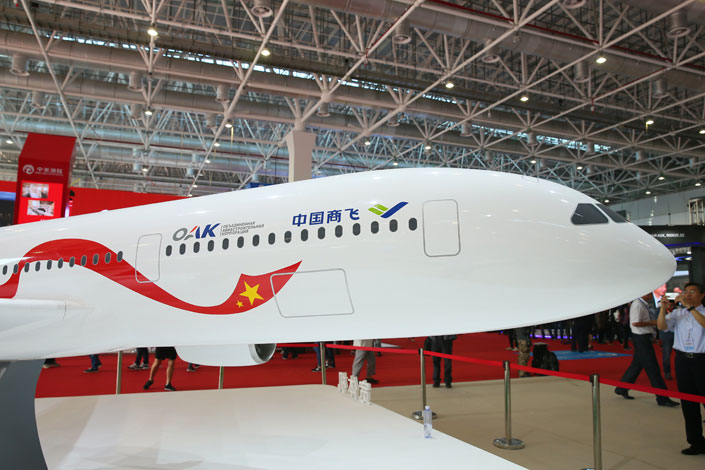Sino-Russian Venture Plans Long-Haul Jetliner by 2027

(Beijing) – Chinese and Russian aircraft manufacturers have launched a $12 billion, Shanghai-based joint venture aimed at developing a wide-body, long-haul passenger jet for a global market dominated by Boeing and Airbus.
Commercial Aircraft Corp. of China (COMAC) and Russia’s United Aircraft Corp. (UAC) on Monday announced the 50-50 joint venture along with plans to develop over the next decade a 280-seat airliner with a range of 12,000 kilometers.
The announcement of a project to build a long-haul, dual-aisle aircraft came less than three weeks after the maiden flight of COMAC’s new C919 single-aisle, regional passenger jet.
COMAC’s deal with UAC underscores the Chinese company’s interest in competing against Boeing and Airbus in markets for long-range as well as regional passenger airliners.
The basis for the new venture called China-Russia Commercial Aircraft International Co. Ltd. (CRAIC) was a memorandum of understanding signed by representatives from the two nations in 2014. The memorandum led to a contract agreement in June 2016. China’s antimonopoly authorities gave the venture a green light in April.
Under the deal, each partner controls four seats on an eight-member CRAIC board of directors. UAC vice president Vladislav Masolov was named chairman and Guo Bozhi, assistant to the Chairman at COMAC, will serve as general manager of the new company.
Moscow will be home to the company’s research and development engineering center, while aircraft assembly operations will be based in Shanghai, which is also COMAC’s headquarters. UAC’s responsibilities include wing development tasks, while its Chinese partner will work on aircraft body design and manufacturing.
The joint venture marks a major step forward for China’s ambitious effort to design and build competitive, commercial aircraft, COMAC President Jin Zhuanglong said at a ceremony where the joint venture was announced.
“With the successful maiden flight of the C919, conditions for the wide-body project are now ripe,” Jin said, adding that he’s optimistic about domestic and international market opportunities for the Sino-Russian aircraft.
Jin said CRAIC’s first wide-body aircraft could fly its maiden voyage around 2024, and the first delivery could come as early as 2027.
Masolov said the new airliner is expected to control about 10% of the market currently shared by the Airbus A340, A350 and A380 jets, and the Boeing 777 and 787 aircraft.
Global demand for technologically sophisticated, wide-body jets is expected to grow in coming years as air travel becomes more common in developing countries. A 2016 report by Boeing said the world’s airlines may buy as many as 8,830 wide-body aircraft over the next two decades, with nearly one-fourth of that demand coming from China.
Wide-body aircraft currently comprise slightly more than one-fifth of the entire worldwide airliner fleet. Because they’re expensive, these aircraft are responsible for more than 50% of the value of the commercial airliner market.
Contact reporter April Ma (fangjingma@caixin.com )

- 1In Depth: The Unfinished Transformation of China’s LGFVs
- 2In Depth: Chinese Firms Face Shifting Global IPO Landscape
- 3Chart of the Day: CATL Leads Chinese Clean-Tech Firms in Overseas Investments
- 4Exclusive: Former ICBC Ally of Fallen Finance Czar Yi Huiman Unreachable
- 5U.S. Details Steep Port Fees on China-Linked Vessels Starting Oct. 14
- 1Power To The People: Pintec Serves A Booming Consumer Class
- 2Largest hotel group in Europe accepts UnionPay
- 3UnionPay mobile QuickPass debuts in Hong Kong
- 4UnionPay International launches premium catering privilege U Dining Collection
- 5UnionPay International’s U Plan has covered over 1600 stores overseas






